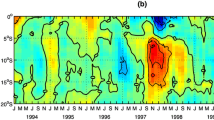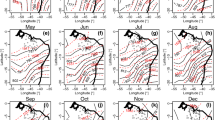Abstract
Mesoscale nocturnal jetlike winds have been observed over a flat, open coast. They occur within the planetary boundary layer between 100 and 600 m. At times the wind shear may reach 15 m s-1 per 100 m. Unlike the common low-level jet that occurs most often at the top of the nocturnal inversion and only with a wind from the southerly quadrant, this second kind of jet exists between nocturnal ground-based inversion layers formed by the ‘cool pool’, or mesohigh, and the elevated mesoscale inversion layer over the coast. It occurs mostly when light % MathType!MTEF!2!1!+-% feaafiart1ev1aaatCvAUfeBSjuyZL2yd9gzLbvyNv2CaerbuLwBLn% hiov2DGi1BTfMBaeXatLxBI9gBaerbd9wDYLwzYbItLDharqqtubsr% 4rNCHbGeaGqiVu0Je9sqqrpepC0xbbL8F4rqqrFfpeea0xe9Lq-Jc9% vqaqpepm0xbba9pwe9Q8fs0-yqaqpepae9pg0FirpepeKkFr0xfr-x% fr-xb9adbaqaaeGaciGaaiaabeqaamaabaabaaGcbaGaaiikaiabgs% MiJkaaiwdacqGHsislcaaI2aGaaeyBaiaabccacaqGZbWaaWbaaSqa% beaacqGHsislcaaIXaaaaOGaaiykaaaa!3FCF!\[( \leqslant 5 - 6{\text{m s}}^{ - 1} )\] geostrophic winds blow from land to sea and when the air temperature over adjacent seas is more than 5 °C warmer than that over the coast. This phenomenon may be explained by combined Venturi and gravity-wind effects existing in a region from just above the area a few kilometres offshore to 100–600 m in height approximately 40–50 km inland because this region is ‘sandwiched’ between the aforementioned two inversion layers.
Similar content being viewed by others
References
Blackadar, A. K.: 1960, ‘A Survey of Wind Characteristics Below 1500 ft’, Meteorol. Monogr. 4: 22, 3–11.
Eigsti, S. L.: 1978, ‘The Coastal Diurnal Wind Cycle at Port Aransas, Texas’, Report No. 4, University of Texas Atmospheric Science Group, Austin, Texas.
Holzworth, G. C.: 1972 ‘Mixing Heights, Wind Speeds, and Potential for Urban Air Pollution Throughout the Contiguous United States’, Office of Air Programs Publication No. AP-101, Environmental Protection Agency, Research Triangle Park, North Carolina.
Hsu, S. A.: 1969, ‘Mesoscale Structure of the Texas Coast Sea Breeze’, Report No. 16, University of Texas Atmospheric Science Group, Austin, Texas.
Hull, L., Dannevik, W., et al.: 1977, ‘Meteorological Analysis for the Anclote Keys Plume Study, February 1977’, submitted to the Atmospheric Chemistry and Physics Division, Environmental Protection Agency (Contract No. 68–02–2500), Research Triangle Park, North Carolina.
Lettau, H.: 1954, ‘Graphs and Illustrations of Diverse Atmospheric States and Processes Observed During the Seventh Test Period of the Great Plains Turbulence Field Program’, Occasional Rep. No. 1, Atmos. Anal. Lab., Geophys. Res. Dir., Cambridge, Mass.
Yu, T. W. and Wagner, N. K.: 1970, ‘Diurnal Variation of Kinetic and Internal Energy in Onshore Winds Along the Upper Texas Coast’, Rep. No. 19, University of Texas Atmospheric Science Group, Austin, Texas.
Author information
Authors and Affiliations
Rights and permissions
About this article
Cite this article
Hsu, S.A. Mesoscale nocturnal jetlike winds within the planetary boundary layer over a flat, open coast. Boundary-Layer Meteorol 17, 485–494 (1979). https://doi.org/10.1007/BF00118612
Accepted:
Issue Date:
DOI: https://doi.org/10.1007/BF00118612




